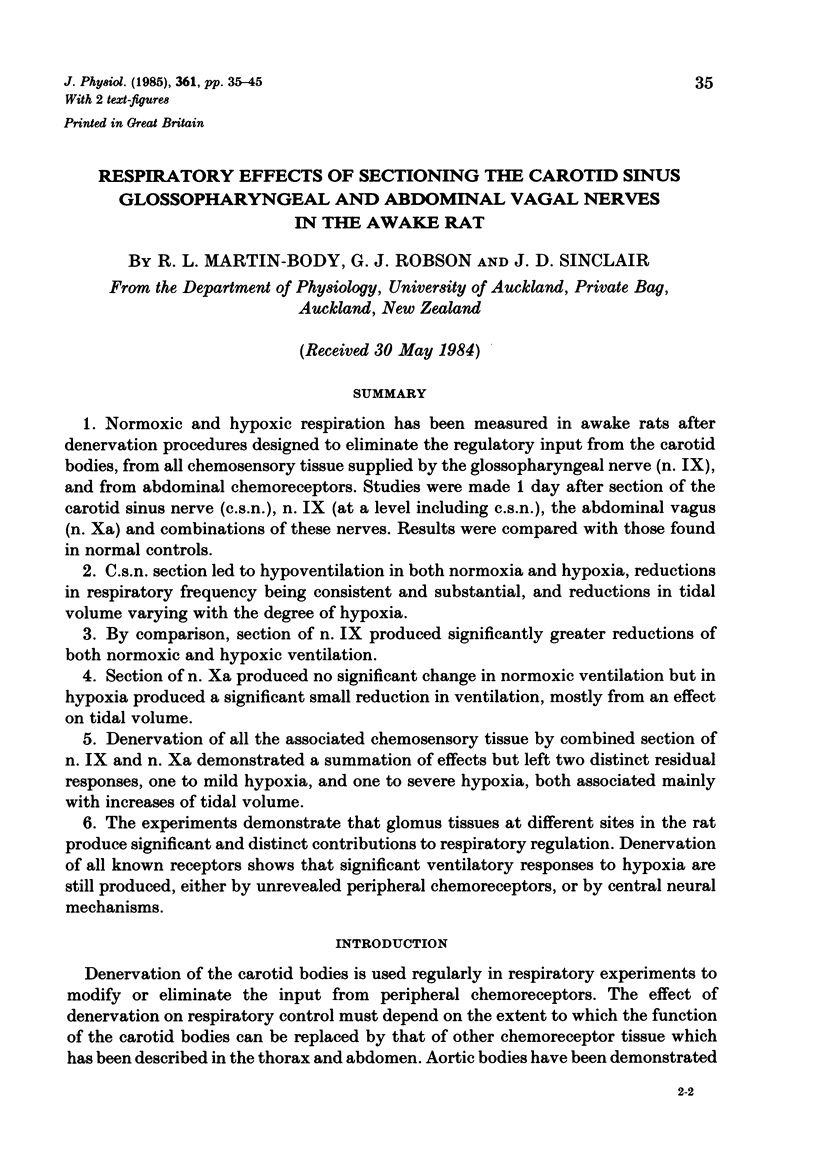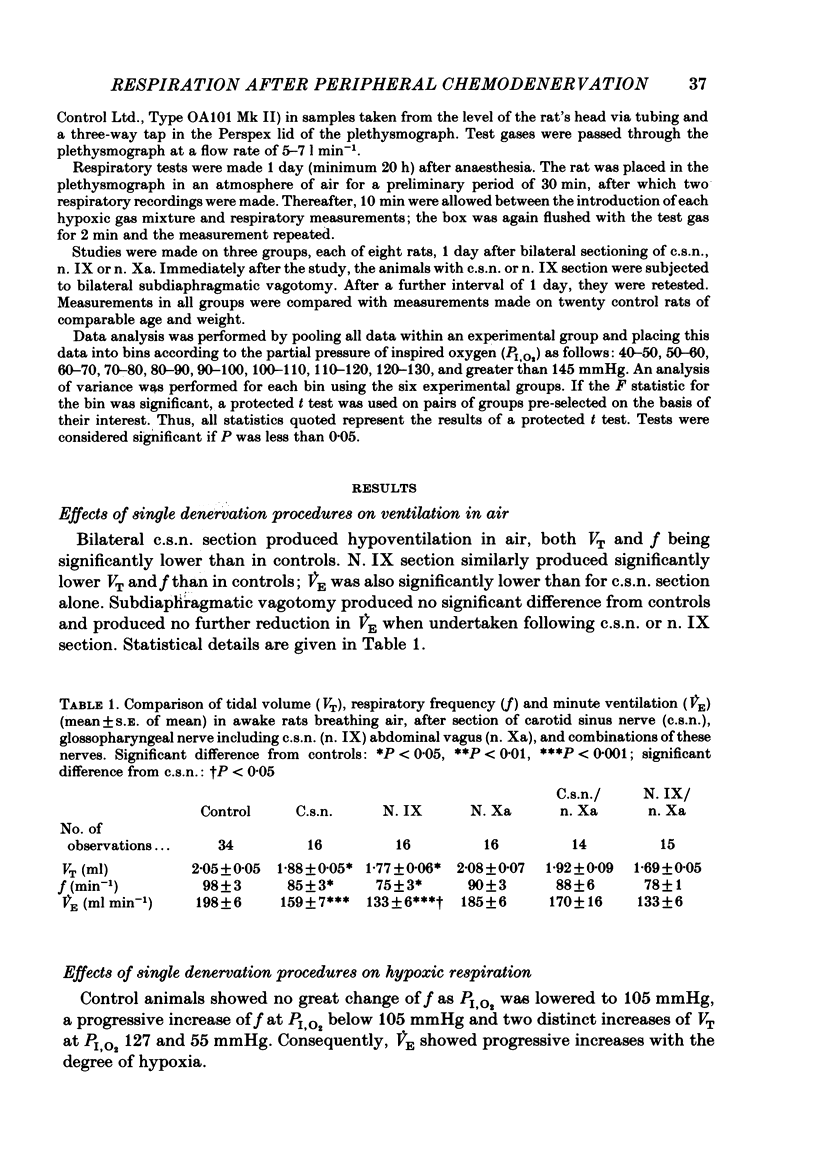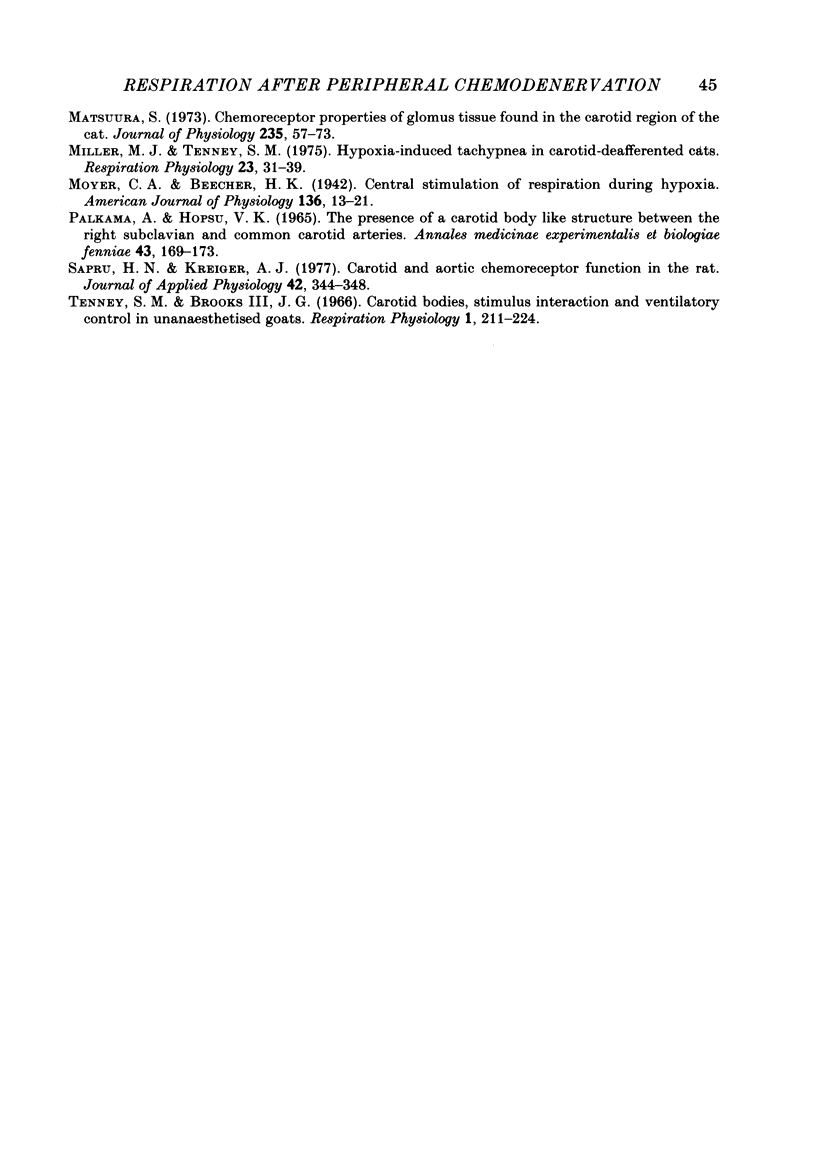Abstract
Normoxic and hypoxic respiration has been measured in awake rats after denervation procedures designed to eliminate the regulatory input from the carotid bodies, from all chemosensory tissue supplied by the glossopharyngeal nerve (n. IX), and from abdominal chemoreceptors. Studies were made 1 day after section of the carotid sinus nerve (c.s.n.), n. IX (at a level including c.s.n.), the abdominal vagus (n. Xa) and combinations of these nerves. Results were compared with those found in normal controls. C.s.n. section led to hypoventilation in both normoxia and hypoxia, reductions in respiratory frequency being consistent and substantial, and reductions in tidal volume varying with the degree of hypoxia. By comparison, section of n. IX produced significantly greater reductions of both normoxic and hypoxic ventilation. Section of n. Xa produced no significant change in normoxic ventilation but in hypoxia produced a significant small reduction in ventilation, mostly from an effect on tidal volume. Denervation of all the associated chemosensory tissue by combined section of n. IX and n. Xa demonstrated a summation of effects but left two distinct residual responses, one to mild hypoxia, and one to severe hypoxia, both associated mainly with increases of tidal volume. The experiments demonstrate that glomus tissues at different sites in the rat produce significant and distinct contributions to respiratory regulation. Denervation of all known receptors shows that significant ventilatory responses to hypoxia are still produced, either by unrevealed peripheral chemoreceptors, or by central neural mechanisms.
Full text
PDF










Selected References
These references are in PubMed. This may not be the complete list of references from this article.
- Andrews W. H., Deane B. M., Howe A., Orbach J. Abdominal chemoreceptors in the rat. J Physiol. 1972 Apr;222(1):84P–85P. [PubMed] [Google Scholar]
- Bartlett D., Jr, Tenney S. M. Control of breathing in experimental anemia. Respir Physiol. 1970 Oct;10(3):384–395. doi: 10.1016/0034-5687(70)90056-3. [DOI] [PubMed] [Google Scholar]
- Bisgard G. E., Forster H. V., Klein J. P., Manohar M., Bullard V. A. Depression of ventilation by dopamine in goats--effects of carotid body excision. Respir Physiol. 1980 Jun;40(3):379–392. doi: 10.1016/0034-5687(80)90036-5. [DOI] [PubMed] [Google Scholar]
- Bisgard G. E., Forster H. V., Klein J. P. Recovery of peripheral chemoreceptor function after denervation in ponies. J Appl Physiol Respir Environ Exerc Physiol. 1980 Dec;49(6):964–970. doi: 10.1152/jappl.1980.49.6.964. [DOI] [PubMed] [Google Scholar]
- Bisgard G. E., Forster H. V., Orr J. A., Buss D. D., Rawlings C. A., Rasmussen B. Hypoventilation in ponies after carotid body denervation. J Appl Physiol. 1976 Feb;40(2):184–190. doi: 10.1152/jappl.1976.40.2.184. [DOI] [PubMed] [Google Scholar]
- Bisgard G. E., Vogel J. H. Hypoventilation and pulmonary hypertension in calves after carotid body excision. J Appl Physiol. 1971 Sep;31(3):431–437. doi: 10.1152/jappl.1971.31.3.431. [DOI] [PubMed] [Google Scholar]
- Bouverot P., Candas V., Libert J. P. Role of the arterial chemoreceptors in ventilatory adaptation to hypoxia of awake dogs and rabbits. Respir Physiol. 1973 Mar;17(2):209–219. doi: 10.1016/0034-5687(73)90062-5. [DOI] [PubMed] [Google Scholar]
- Cardenas H., Zapata P. Ventilatory reflexes originated from carotid and extracarotid chemoreceptors in rats. Am J Physiol. 1983 Jan;244(1):R119–R125. doi: 10.1152/ajpregu.1983.244.1.R119. [DOI] [PubMed] [Google Scholar]
- Chalmers J. P., Korner P. I., White S. W. The relative roles of the aortic and carotid sinus nerves in the rabbit in the control of respiration and circulation during arterial hypoxia and hypercapnia. J Physiol. 1967 Feb;188(3):435–450. doi: 10.1113/jphysiol.1967.sp008148. [DOI] [PMC free article] [PubMed] [Google Scholar]
- Chapman R. W., Santiago T. V., Edelman N. H. Effects of graded reduction of brain blood flow on ventilation in unanesthetized goats. J Appl Physiol Respir Environ Exerc Physiol. 1979 Jul;47(1):104–111. doi: 10.1152/jappl.1979.47.1.104. [DOI] [PubMed] [Google Scholar]
- Chen I. L., Yates R. D. Ultrastructural studies of vagal paraganglia in Syrian hamsters. Z Zellforsch Mikrosk Anat. 1970;108(3):309–323. doi: 10.1007/BF00336522. [DOI] [PubMed] [Google Scholar]
- Cherniack N. S., Edelman N. H., Lahiri S. Hypoxia and hypercapnia as respiratory stimulants and depressants. Respir Physiol. 1970;11(1):113–126. doi: 10.1016/0034-5687(70)90107-6. [DOI] [PubMed] [Google Scholar]
- Coleridge H. M., Coleridge J. C., Howe A. Thoracic chemoreceptors in the dog. A histological and electrophysiological study of the location, innervation and blood supply of the aortic bodies. Circ Res. 1970 Feb;26(2):235–247. doi: 10.1161/01.res.26.2.235. [DOI] [PubMed] [Google Scholar]
- Coleridge H., Coleridge J. C., Howe A. Search for pulmonary arterial chemoreceptors in the cat, with a comparison of the blood supply of the aortic bodies in the newborn & adult animal. J Physiol. 1967 Jul;191(2):353–374. doi: 10.1113/jphysiol.1967.sp008255. [DOI] [PMC free article] [PubMed] [Google Scholar]
- DRORBAUGH J. E., FENN W. O. A barometric method for measuring ventilation in newborn infants. Pediatrics. 1955 Jul;16(1):81–87. [PubMed] [Google Scholar]
- Davis J. N., Carlsson A. The effect of hypoxia on monoamine synthesis, levels and metabolism in rat brain. J Neurochem. 1973 Oct;21(4):783–790. doi: 10.1111/j.1471-4159.1973.tb07522.x. [DOI] [PubMed] [Google Scholar]
- Dawes G. S. The central control of fetal breathing and skeletal muscle movements. J Physiol. 1984 Jan;346:1–18. doi: 10.1113/jphysiol.1984.sp015003. [DOI] [PMC free article] [PubMed] [Google Scholar]
- Dempsey J. A., Forster H. V. Mediation of Ventilatory Adaptations. Physiol Rev. 1982 Jan;62(1):262–346. doi: 10.1152/physrev.1982.62.1.262. [DOI] [PubMed] [Google Scholar]
- Favier R., Lacaisse A. Stimulus oxygène de la ventilation chez le rat éveillé. J Physiol (Paris) 1978;74(4):411–417. [PubMed] [Google Scholar]
- Gautier H., Bonora M. Effects of carotid body denervation on respiratory pattern of awake cats. J Appl Physiol Respir Environ Exerc Physiol. 1979 Jun;46(6):1127–1131. doi: 10.1152/jappl.1979.46.6.1127. [DOI] [PubMed] [Google Scholar]
- Gautier H., Bonora M. Possible alterations in brain monoamine metabolism during hypoxia-induced tachypnea in cats. J Appl Physiol Respir Environ Exerc Physiol. 1980 Nov;49(5):769–777. doi: 10.1152/jappl.1980.49.5.769. [DOI] [PubMed] [Google Scholar]
- Goormaghtigh N. On the Existence of Abdominal Vagal Paraganglia in the Adult Mouse. J Anat. 1936 Oct;71(Pt 1):77–90.3. [PMC free article] [PubMed] [Google Scholar]
- Howe A., Pack R. J., Wise J. C. Arterial chemoreceptor-like activity in the abdominal vagus of the rat. J Physiol. 1981 Nov;320:309–318. doi: 10.1113/jphysiol.1981.sp013951. [DOI] [PMC free article] [PubMed] [Google Scholar]
- Krasney J. A., Magno M. G., Levitzky M. G., Koehler R. C., Davies D. G. Cardiovascular responses to arterial hypoxia in awake sinoaortic-denervated dogs. J Appl Physiol. 1973 Nov;35(5):733–738. doi: 10.1152/jappl.1973.35.5.733. [DOI] [PubMed] [Google Scholar]
- Lauweryns J. M., Cokelaere M. Hypoxia-sensitive neuro-epithelial bodies. Intrapulmonary secretory neuroreceptors, modulated by the CNS. Z Zellforsch Mikrosk Anat. 1973 Dec 21;145(4):521–540. doi: 10.1007/BF00306722. [DOI] [PubMed] [Google Scholar]
- Lee L. Y., Milhorn H. T., Jr Central ventilatory responses to O2 and CO2 at three levels of carotid chemoreceptor stimulation. Respir Physiol. 1975 Dec;25(3):319–333. doi: 10.1016/0034-5687(75)90007-9. [DOI] [PubMed] [Google Scholar]
- Maskrey M., Megirian D., Nicol S. C. Effects of decortication and carotid sinus nerve section on ventilation of the rat. Respir Physiol. 1981 Mar;43(3):263–273. doi: 10.1016/0034-5687(81)90108-0. [DOI] [PubMed] [Google Scholar]
- Matsuura S. Chemoreceptor properties of glomus tissue found in the carotid region of the cat. J Physiol. 1973 Nov;235(1):57–73. doi: 10.1113/jphysiol.1973.sp010378. [DOI] [PMC free article] [PubMed] [Google Scholar]
- Miller M. J., Tenney S. M. Hypoxia-induced tachypnea in carotid-deafferented cats. Respir Physiol. 1975 Jan;23(1):31–39. doi: 10.1016/0034-5687(75)90069-9. [DOI] [PubMed] [Google Scholar]
- Palkama A., Hopsu V. K. The presence of carotid body like structure between the right subclavian and common carotid arteries. Ann Med Exp Biol Fenn. 1965;43(3):169–173. [PubMed] [Google Scholar]
- Sapru H. N., Krieger A. J. Carotid and aortic chemoreceptor function in the rat. J Appl Physiol Respir Environ Exerc Physiol. 1977 Mar;42(3):344–348. doi: 10.1152/jappl.1977.42.3.344. [DOI] [PubMed] [Google Scholar]
- Tenney S. M., Brooks J. G., 3rd Carotid bodies, stimulus interaction, and ventilatory control in unanesthetized goats. Respir Physiol. 1966;1(2):211–224. doi: 10.1016/0034-5687(66)90018-1. [DOI] [PubMed] [Google Scholar]


